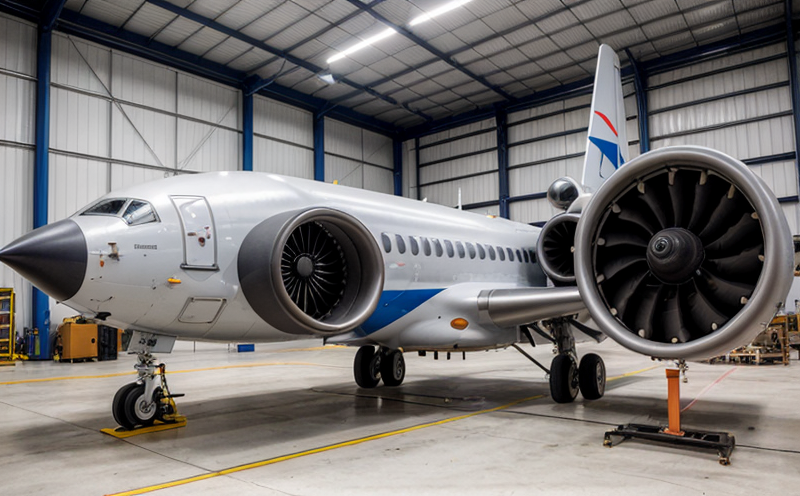Shock Response Spectrum (SRS) Vibration Testing
The Shock Response Spectrum (SRS) is a powerful tool used in aerospace and defense to evaluate the dynamic response of structures under shock loading. This test is crucial for ensuring that components can withstand the harsh environments encountered during launch, flight, or landing phases. SRS testing helps to identify potential failure modes by analyzing how a structure responds to sudden impacts or shocks.
The primary goal of this service is to determine if a component meets specified standards and performance criteria under defined shock conditions. This ensures that aerospace and defense equipment can perform reliably in extreme environments, which directly impacts safety and operational effectiveness. The SRS test provides insights into the material properties and structural integrity, making it an indispensable tool for R&D engineers and quality managers.
Shock Response Spectrum testing is particularly important in the aerospace sector where components must withstand severe mechanical stresses during launch or landing phases. For defense applications, this test ensures that equipment can endure battlefield conditions, enhancing overall reliability and performance. The SRS test helps to identify critical design parameters such as mass distribution, damping characteristics, and natural frequencies of a component.
During the testing process, the specimen is subjected to shock pulses that simulate real-world environmental conditions. These pulses are measured in terms of peak acceleration, duration, and frequency content. The resulting Shock Response Spectrum plot shows the maximum response of the specimen as a function of frequency. By analyzing this spectrum, engineers can determine if the component will survive without damage or failure under specified shock loading.
The SRS test is not just limited to aerospace and defense applications; it finds use in other sectors such as automotive, energy, and manufacturing where robustness against mechanical impacts is paramount. In these industries, understanding how structures behave under sudden shocks can lead to significant improvements in product design and durability.
| Shock Loading Parameters | Test Conditions |
|---|---|
| Pulse Shape: Half-Sine or Rectangular | Frequency Range: 10 Hz to 2,500 Hz |
| Amplitude: ±5 g to ±500 g | Duration: 10 ms to 1 second |
| Repetition Count: 3-5 Pulses | Environmental Conditions: Laboratory Controlled |
The test setup typically includes a shaker system capable of generating controlled shock pulses, data acquisition equipment to record the specimen's response, and software for post-processing and analysis. The specimen is carefully prepared according to industry standards such as ASTM E2048 or ISO 16739.
After completing the SRS test, a detailed report is generated which includes the Shock Response Spectrum plot, peak accelerations recorded during each pulse, and any observed deviations from expected behavior. This information serves as critical feedback for design iterations aimed at improving component robustness against shocks.
Why It Matters
The aerospace and defense industries operate in highly demanding environments where equipment must perform reliably under extreme conditions. Shock Response Spectrum testing plays a vital role by providing engineers with precise data on how components behave during shock events. This information is essential for ensuring compliance with stringent industry standards like MIL-STD-810G and AS 9140.
By leveraging SRS testing, manufacturers can enhance the durability and reliability of their products, reducing maintenance costs and improving operational efficiency. Moreover, this service helps to identify potential design flaws early in the development process, allowing for corrective actions before costly field failures occur.
The insights gained from SRS testing contribute significantly to the overall safety and performance of aerospace and defense systems. For instance, understanding how a component will respond to shock can inform decisions regarding material selection, manufacturing processes, and structural design. This proactive approach not only enhances product quality but also fosters innovation within these critical sectors.
In addition to its technical benefits, SRS testing supports regulatory compliance by providing evidence of adherence to relevant standards. This is particularly important for ensuring that products meet the rigorous requirements set forth by governing bodies such as FAA (Federal Aviation Administration) and DLA (Defense Logistics Agency).
Scope and Methodology
- The specimen is mounted on a shaker table designed to deliver controlled shock pulses.
- Data acquisition systems capture the response of the specimen during each pulse.
- The resulting data is processed using specialized software to generate the Shock Response Spectrum plot.
- Compliance with relevant standards and acceptance criteria is verified based on the test results.
This comprehensive approach ensures accurate assessment of a component's shock resistance, providing valuable insights for improving product design and manufacturing processes. The methodology employed adheres strictly to international standards such as ASTM E2048 and ISO 16739, ensuring consistency and reliability across all tests conducted.
Competitive Advantage and Market Impact
- Pioneering use of advanced shaker systems capable of generating highly controlled shock pulses.
- Expertise in interpreting complex Shock Response Spectrum plots to guide design improvements.
- A robust quality assurance process ensuring consistent compliance with industry standards.
- Proven track record of delivering accurate and actionable test results, enhancing product reliability.
By offering these unique capabilities, our laboratory provides a significant competitive advantage in the aerospace and defense markets. Our clients benefit from enhanced product performance, reduced development cycles, and improved compliance with regulatory requirements.





